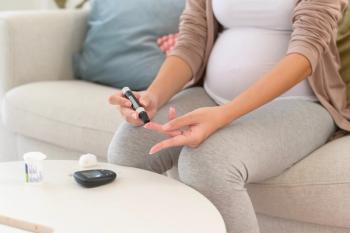
Postpartum Depression and Its Long-Term Effects on Children
Evidence suggests that both persistent and severe postpartum depression increase the risk of adverse outcomes in children.
Some women begin to feel anxious and depressed within a few days of giving birth. Many also experience crying spells for no clear reason, have trouble making decisions and sleeping, lose their appetite, and become angry at their newborn, other children, or significant other. These feelings, often referred to as the baby blues, typically last a few days to 2 weeks.1,2 Affecting up to 80% of mothers, the baby blues are usually not severe enough to require treatment.1-3
On the other hand, postpartum depression involves intense feelings of anxiety, hopelessness, or sadness that last much longer, affecting the mother’s day-to-day life. Women who have postpartum depression develop symptoms an average of 1 to 3 weeks after childbirth, but the onset can be anytime during the first year after childbirth.1,2 Postpartum, or postnatal, depression is estimated to affect 10% of women in wealthier countries, and an even higher percentage in countries that are less wealthy.4
RISK FACTORS
Some women are at a higher risk of developing postpartum depression. Women who experience depression during pregnancy tend to be at a greater risk of depression after giving birth. About 50% of women with postpartum depression experienced depression before or during pregnancy.2,5 Other mental disorders during pregnancy, such as anxiety or obsessive-compulsive disorder, are associated with a higher risk of postpartum depression. Risk factors include a lack of emotional support; medical complications during childbirth, such as premature delivery; and mixed feelings about the pregnancy.2,5
CAUSES
Although the cause of postpartum depression is not known, it is believed that hormonal changes may play a role. Connected to this is that researchers suspect that changes in 2 genes may play a role in increasing the risk of developing postpartum depression. This belief is supported by findings from a small 2013 study. These genes are thought to be involved in the activity of the hippocampus and appear to respond to estrogen.5 Estrogen comes into play because, during pregnancy, estrogen and progesterone levels increase, only to rapidly return to normal within 24 hours of childbirth. It is this rapid change in hormone levels that is thought to be related to postpartum depression.5
EFFECT ON CHILDREN
Netsi et al looked at the long-term effects of persistent, severe postpartum depression and its effects on children. To evaluate the impact, the researchers used data from the British Avon Longitudinal Study of Parents and Children.4,6 For details of the study, see the table.4.6
Evidence suggests that both persistent and severe postpartum depression increase the risk of adverse outcomes in children.4 Research has listed an association between postpartum depression and delayed cognitive and language development, disorganized or insecure attachment, higher rates of behavioral problems, and lower grades. In addition, there is a documented link between postpartum depression and higher rates of depression in children during the latter teen years (16 to 18 years old).4
Women who met the criteria for moderate and severe postpartum depression at 2 months and at 8 months post delivery made up the most vulnerable group and were found to be more likely to experience depression 11 years later.6
Myrna M. Weissman, PhD, analyzed the study, conducted by Netsi et al, and concluded that children born to women in the most vulnerable group have a 2-fold increased risk of having lower math scores at 16 years, a 4-fold greater risk of having behavioral problems between ages 3 and 4 years, and a 7-fold higher risk of depression at 18 years.4,6 She said that these findings suggest extending the universal screening for depression in all pregnant women to screening beyond pregnancy, possibly up to a year after delivery and during baby wellness visits.6
This study was not free of limitations. One was the high rate of attrition, which may have led to an underestimation of the proportion of women who experience persistent and severe postpartum depression.4,6 Another was that the study could not determine the effects of treating postpartum depression using antidepressants or psychological treatment in the women and whether that reduced postpartum depression and improved child outcomes.4,6
OTHER RESEARCH
Shen et al found that though maternal and paternal depression can negatively affect child development, the paternal effect is less compared with the maternal effect.6 Another study found that reducing the symptoms of depression in a parent to remission can reduce adverse effects on the child.6
IN THE NEWS
Sage Therapeutics said that brexanolone (formerly SAGE-547) achieved primary end points in 2 phase 3 clinical trials in moderate (Study 202C) and severe (Study 202B) postpartum depression. The primary end point was a mean reduction from baseline in the Hamilton Rating Scale for Depression total score at 60 hours.7
Brexanolone is listed as an allosteric modulator of both synaptic and extrasynaptic GABAA receptors and is a proprietary formulation of allopregnanolone, a naturally occurring molecule that is known to modulate GABA receptor activity.8 Its mechanism of action leads to varying degrees of desired activity versus complete receptor activation or inhibition.7 Available in an intravenous formulation, brexanolone has been granted breakthrough therapy status by the FDA.7 Sage is planning to file a new drug application with the FDA later this year for brexanolone and is seeking approval for its use in treating postpartum depression. Its plan is to bring brexanolone to the market in early 2019.9
Anyssa Garza, PharmD, BCMAS, received her doctor of pharmacy degree from The University of Texas at Austin. She is the vice president of Content and Patient Education Programs at Digital Pharmacist and an adjunct assistant professor at The University of Texas at Austin College of Pharmacy.
References
- American College of Obstetricians and Gynecologists. Postpartum depression. ACOG website. acog.org/Patients/FAQs/Postpartum-Depression. Published December 2013. Accessed April 21, 2018.
- Office on Women’s Health. Depression during and after pregnancy. Office on Women’s Health website. womenshealth.gov/publications/our-publications/fact-sheet/ depression-pregnancy.html. Updated June 12, 2017. Accessed April 21, 2018.
- National Institute of Mental Health. Postpartum depression facts. NIMH website. nimh.nih.gov/health/publications/postpartum-depression-facts/index.shtml. Accessed April 21, 2018.
- Netsi E, Pearson RM, Murray L, Cooper P, Craske MG, Stein A. Association of persistent and severe postnatal depression with child outcomes. JAMA Psychiatry. 2018;75(3):247-253. doi: 10.1001/jamapsychiatry.2017.4363.
- Postpartum depression. In: Longe JL, ed. The Gale Encyclopedia of Psychology. 3rd ed. Farmington Hills, MI: Gale; 2016:902-905.
- Weissman MM. Postpartum depression and its long-term impact on children. many new questions. JAMA Psychiatry. 2018;75(3):227-228. doi: 10.1001/jamapsychiatry.2017.4265.
- Sage Therapeutics announces brexanolone achieves primary endpoints in both phase 3 clinical trials in postpartum depression [news release]. Cambridge, MA: November 9, 2017. investor.sagerx.com/news-releases/news-release-details/sage-therapeutics-announces-brexanolone-achieves-primary. Accessed April 22, 2018.
- Sage Therapeutics. Our programs. Sage website. sagerx.com/programs.php. Accessed April 22, 2018.
- Keown A. Sage Therapeutics looks to file NDA for postpartum depression treatment later this year. BioSpace website. biospace.com/article/exclusive-sage- therapeutics-looks-to-file-nda-for-postpartum-depression-treatment-later-this-year/. Published January 12, 2018. Accessed April 22, 2018.
Newsletter
Stay informed on drug updates, treatment guidelines, and pharmacy practice trends—subscribe to Pharmacy Times for weekly clinical insights.









































































































































































































